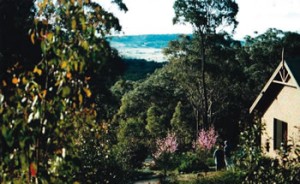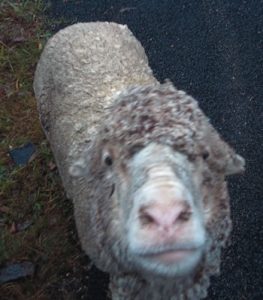The Lost Sheep
I like to think I’m a hard bitten journalist after a lifetime in the profession, covering the best and worst of the human condition on three continents. So why should I be upset about the death of an old sheep?
Almost 20 years ago I decided to return to my roots, the bush. I grew up on a north Queensland cattle station in the Charters Towers district’s high country until, with the tragic death of my father, the family moved into town and during tough war years, I was sent to boarding school.
Journalism took me to Townsville, Brisbane, London’s Fleet Street, New York, Canberra, then back to Brisbane for 13 exhausting years as editor of The Catholic Leader. We found on a long weekend what I’d been hankering for all those years: a 2ha (five-acre) bush block on the edge of Glen Innes in the New England Tablelands of northern New South Wales.
It was reminiscent of the idyllic setting of the family cattle property I knew briefly, but never forgot, as a child. The block was high on a slope, screened by she-oaks, with prolific eucalypts, wild, flowering shrubs, mossy-covered rocks, kangaroos, multi-coloured parrots, rare black cockatoos, a home site, dam, and in the distance, a ring of blue hills.
We found the Glen Innes community warm and friendly; a colonial town and district settled in the 1830s where the outlaw Thunderbolt roamed and Australia’s first saint Mary MacKillop visited often, signing the deeds for the convent on the highway, its imposing replacement, now without nuns and advertising budget accommodation for $39.
We built a weekend cottage and then, with semi-retirement, extended it into a family home, enjoying the physical activity of fencing, building paths and rock walls with those mossy-covered rocks, stabilising banks with our own timber, developing gardens and enjoying the companionship of wildlife.
Returning from Christmas holidays, we were surprised to find two stray sheep on the block. I called the ranger whose dog quickly rounded up one. But the other, with an impressive turn of speed, headed for the far corners of the block. Ranger and dog gave up in frustration. I spread the word about the ewe, not wishing to be accused of sheep stealing. No one responded, even though I was assured she was an exceptionally well-bred Merino with top grade, fine wool.
Seemingly well aware of her breeding, she was snooty, so we called her Hyacinth after Mrs Bucket of television fame. Each morning, she’d call me with well modulated bleats from the banks of the dam for a breakfast titbit, but it had to be just so; bread from the kitchen scrap bucket, preferably with a scraping of Vegemite. Any with traces of tea leaves were rejected with a pronounced sniff. She was also partial to the odd slice of fruit and top quality lucerne hay. All my attempts at friendship were rejected, conveying unmistakably that familiarity breeds contempt.
Friends gave us a black sheep to keep Hyacinth company. We called her Hetty; she was young and feisty, thrusting Hyacinth aside for the breakfasts. Hyacinth at first snubbed her, but finally thawed and, while refusing to join in as Hetty skipped and gambolled across the block, tolerated the companionship. The two became inseparable and trotted off together each night to bed down on a patch in the she-oaks.
When Hetty died suddenly and I began digging the grave, Hyacinth roamed the block bleating. But she soon recovered and was happy enough with her own company. She remained aloof, but in her own way was gentle and faithful, insisting on following me everywhere on the block and sitting quietly nearby while I went about chores; we never thought of getting a dog. When an intruding Alsatian savaged her, she submitted meekly to my wife Marianne’s ministrations and the daily prick of an antibiotic needle.
Irascible and stubborn, she’d bound into the garden each time we opened the gate to munch on Marianne’s roses, studiously ignoring her wielding-broom and commands to leave. Hyacinth absconded for days to sample neighbours’ pastures, but would detect unerringly the sound of my car’s engine and race the vehicle all the way home. Equally, she would identify the sound of the engine from a kilometre or so away when we were returning from holidays, and then sulk for days because we’d left her alone. But she knew instinctively if we were driving off to Mass on Sundays or simply going shopping.
She recognised Steve, a farmer friend who came to shear and drench her and for days eluded him on the block. Still, she mellowed with age and became famous around the district for her longevity. I’m told sheep usually live until around 12, but we estimated Hyacinth was heading for 20 and the Guinness Book of Records, one held by a black-faced sheep in Scotland which toppled over a cliff at 25.
It was only recently that age and arthritis caught up with Hyacinth. We found her prostate on the dam, but still voraciously accepted her bread, finally tottering to her feet. Then she disappeared and after a couple of days’ search I found her in a culvert on the block, unable to get up. Strangely, it was near Hetty’s grave and I couldn’t help thinking that perhaps she was heading there for a last pilgrimage. I managed to get her on her feet and she insisted on walking with me up to the house.
But it was only a brief respite. For days she lingered prostate, seemingly without pain, down by the grapevine-covered back fence, still accepting with soulful gaze the bread slices and water from a bowl. Finally, the iron will and remarkable constitution gave out.
We miss Hyacinth and think, whatever about her well-bred snobbery, only of her gentleness and faithfulness. I reflect, too, on the role sheep had in that star-lit field on that first Christmas and of the moving image of the Good Shepherd with a lost sheep over his shoulders and wonder whether it was an accident that another lost one came into our lives all those years ago.
John Coleman is an award winning freelance journalist and travel writer.



 Entries(RSS)
Entries(RSS)